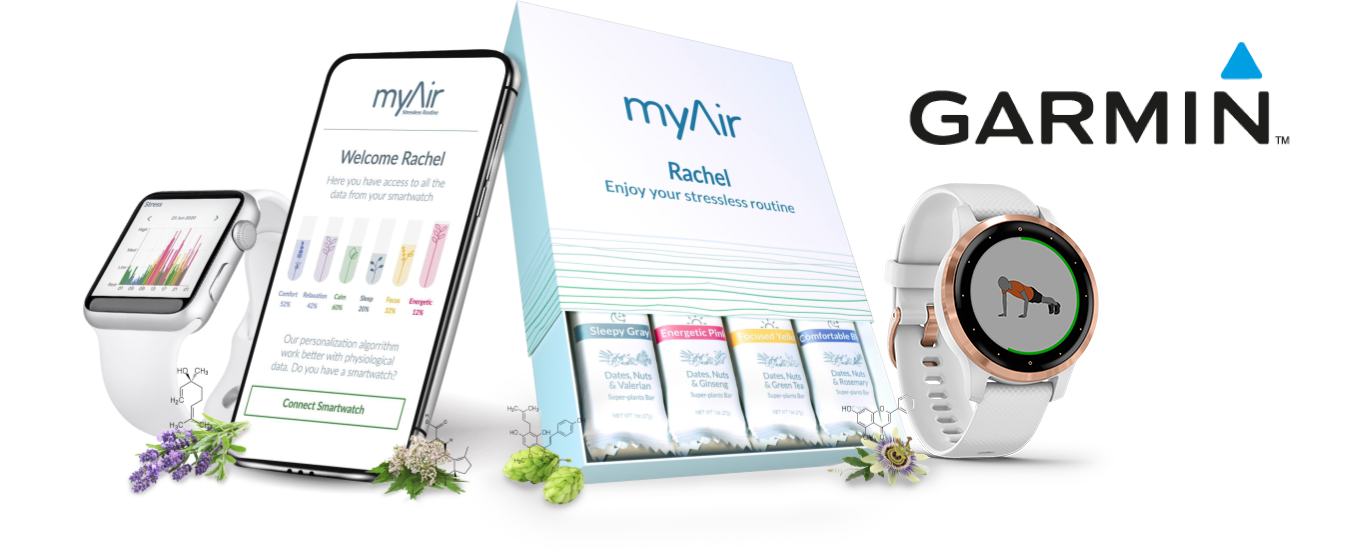
myAir and GARMIN Research: Functional bar enriched with hops and terpenes improve sleep quality and reduced stress: Open-label pilot study
Chronic stress is linked to the six leading causes of death globally, costing American businesses $300 billion each year. If it wasn’t evident enough, stress possesses an obvious cause for concern among individuals, employers and countries worldwide. The good news - relief is readily available. GARMIN wearables come equipped with interactive features that can help users to monitor and manage their stress levels. These wearables also allow users to monitor metrics that specifically influence their stress, such as physical activity, diet, and sleep. Today, thanks to food tech start-up myAir, it’s attainable to use that same data to design customized, plant-based adaptogenic nutrition bars to help users discover even more stress relief in their daily routines.
Improvement in Sleep Quality and Stress Management
An open-label pilot study conducted by myAir issued GARMIN vívosmart® 4 activity wearables to participants to monitor their sleep duration, sleep quality and stress levels. After wearing the device for two weeks to establish baseline measurements, participants were then monitored for a further two weeks with daily consumption of myAir’s adaptogenic super-plant bars.
The study led by Dr. Gil Lewitus from Technion - Israel Institute of Technology found that myAir functional bars improved 73% of participants' anxiety scores and 84% of participants’ sleep quality. Additionally, 54% of the participants increased their sleep duration, and 64% of the participants experienced an increase in deep sleep duration, as measured by the vívosmart 4 devices. The study concluded that bars infused with a proprietary blend of unique adaptogens and hops extract could better enhance sleep quality and relieve stress.
Converting Physiological Data into Personalised Nutrition
Each person experiences different reactions to stress, causing everyone’s symptoms to vary. GARMIN wearable data is individualized to the wearer, meaning it can be used to create a tailored nutrition solution for each user. By integrating the Health API with its platform, myAir allows GARMIN customers to optionally share their wearable data with myAir. Short assessments are also used to help myAir gain psychological insights on each individual. myAir uses the combined quantitative and qualitative data to create a formulation mix that delivers a specific stress-release effect based on each consumer’s unique stress profile and cognitive needs.
myAir x GARMIN
The myAir team analyzed the technical specifications of multiple activity devices before selecting the vívosmart 4 based on its ease of use, reliability, and collection of relevant metrics. myAir Founder Dovev Goldstein said, “We've been using GARMIN devices to track stress, sleep, and activities for a long time. This experience led us to choose GARMIN devices as the most accessible and accurate means to use in large-scale experiments and to reach trusted results.”
Read our research on GARMIN's Blog:
Reference
American Academy of Sleep Medicine. (2001). The international classification of sleep disorders, revised: Diagnostic and coding manual. American Academy of Sleep Medicine.
Babson, K. A., Sottile, J., & Morabito, D. (2017). Cannabis, Cannabinoids, and Sleep: a Review of the Literature. Current Psychiatry Reports. https://doi.org/10.1007/s11920-017-0775-9
Bahi, A., Al Mansouri, S., Al Memari, E., Al Ameri, M., Nurulain, S. M., & Ojha, S. (2014). β-Caryophyllene, a CB2 receptor agonist produces multiple behavioral changes relevant to anxiety and depression in mice. Physiology and Behavior. https://doi.org/10.1016/j.physbeh.2014.06.003
Bent, S., Padula, A., Moore, D., Patterson, M., & Mehling, W. (2006). Valerian for Sleep: A Systematic Review and Meta-Analysis. American Journal of Medicine. https://doi.org/10.1016/j.amjmed.2006.02.026
Buysse, D. J., Reynolds, C. F., Monk, T. H., Berman, S. R., & Kupfer, D. J. (1989). The Pittsburgh sleep quality index: A new instrument for psychiatric practice and research. Psychiatry Research. https://doi.org/10.1016/0165-1781(89)90047-4
Elisabetsky, E., Brum, L. F. S., & Souza, D. O. (1999). Anticonvulsant properties of linalool in glutamate-related seizure models. Phytomedicine. https://doi.org/10.1016/S0944-7113(99)80044-0
Goel, N., Kim, H., & Lao, R. P. (2005). An olfactory stimulus modifies nighttime sleep in young men and women. Chronobiology International. https://doi.org/10.1080/07420520500263276
Höferl, M., Krist, S., & Buchbauer, G. (2006). Chirality influences the effects of linalool on physiological parameters of stress. Planta Medica. https://doi.org/10.1055/s-2006-947202
Jansson-Fröjmark, M., & Lindblom, K. (2008). A bidirectional relationship between anxiety and depression, and insomnia? A prospective study in the general population. Journal of Psychosomatic Research. https://doi.org/10.1016/j.jpsychores.2007.10.016
Kamal, B. S., Kamal, F., & Lantela, D. E. (2018). Cannabis and the Anxiety of Fragmentation—A Systems Approach for Finding an Anxiolytic Cannabis Chemotype. Frontiers in Neuroscience, 12, 730. https://doi.org/10.3389/fnins.2018.00730
Kim, H. G., Cheon, E. J., Bai, D. S., Lee, Y. H., & Koo, B. H. (2018). Stress and heart rate variability: A meta-analysis and review of the literature. Psychiatry Investigation. https://doi.org/10.30773/pi.2017.08.17
Koroch, A. R., Rodolfo Juliani, H., & Zygadlo, J. A. (2007). Bioactivity of essential oils and their components. In Flavours and Fragrances: Chemistry, Bioprocessing and Sustainability. https://doi.org/10.1007/978-3-540-49339-6_5
Lee, J., Jung, H.-Y., Lee, S. I., Choi, J. H., & Kim, S.-G. (, 2020). Effects of Passiflora incarnata Linnaeus on polysomnographic sleep parameters in subjects with insomnia disorder. International Clinical Psychopharmacology. https://doi.org/10.1097/yic.0000000000000291
Lewis, M. A., Russo, E. B., & Smith, K. M. (2018). Pharmacological Foundations of Cannabis Chemovars. Planta Medica. https://doi.org/10.1055/s-0043-122240
Lewith, G. T., Godfrey, A. D., & Prescott, P. (2005). A single-blinded, randomized pilot study evaluating the aroma of Lavandula augustifolia as a treatment for mild insomnia. Journal of Alternative and Complementary Medicine. https://doi.org/10.1089/acm.2005.11.631
Meolie, A. L., Rosen, C., Kristo, D., Kohrman, M., Gooneratne, N., Aguillard, R. N., … Mahowald, M. (2005). Oral nonprescription treatment for insomnia: an evaluation of products with limited evidence. Journal of Clinical Sleep Medicine : JCSM : Official Publication of the American Academy of Sleep Medicine. https://doi.org/10.5664/jcsm.26314
Silva Brum, L. F., Emanuelli, T., Souza, D. O., & Elisabetsky, E. (2001). Effects of linalool on glutamate release and uptake in mouse cortical synaptosomes. Neurochemical Research. https://doi.org/10.1023/A:1010904214482
Smith, M. T., Perlis, M. L., Park, A., Smith, M. S., Pennington, J. M., Giles, D. E., & Buysse, D. J. (2002). Comparative meta-analysis of pharmacotherapy and behavior therapy for persistent insomnia. American Journal of Psychiatry. https://doi.org/10.1176/appi.ajp.159.1.5
Spira, A. P., Beaudreau, S. A., Stone, K. L., Kezirian, E. J., Lui, L. Y., Redline, S., … Stewart, A. (2012). Reliability and validity of the pittsburgh sleep quality index and the epworth sleepiness scale in older men. Journals of Gerontology - Series A Biological Sciences and Medical Sciences. https://doi.org/10.1093/gerona/glr172
Wagner, H., & Ulrich-Merzenich, G. (2009). Synergy research: Approaching a new generation of phytopharmaceuticals. Phytomedicine. https://doi.org/10.1016/j.phymed.2008.12.018
Zanoli, P., & Zavatti, M. (2008). Pharmacognostic and pharmacological profile of Humulus lupulus L. Journal of Ethnopharmacology. https://doi.org/10.1016/j.jep.2008.01.011
Zhang, N., & Yao, L. (2019). Anxiolytic Effect of Essential Oils and Their Constituents: A Review. Journal of Agricultural and Food Chemistry. https://doi.org/10.1021/acs.jafc.9b00433
